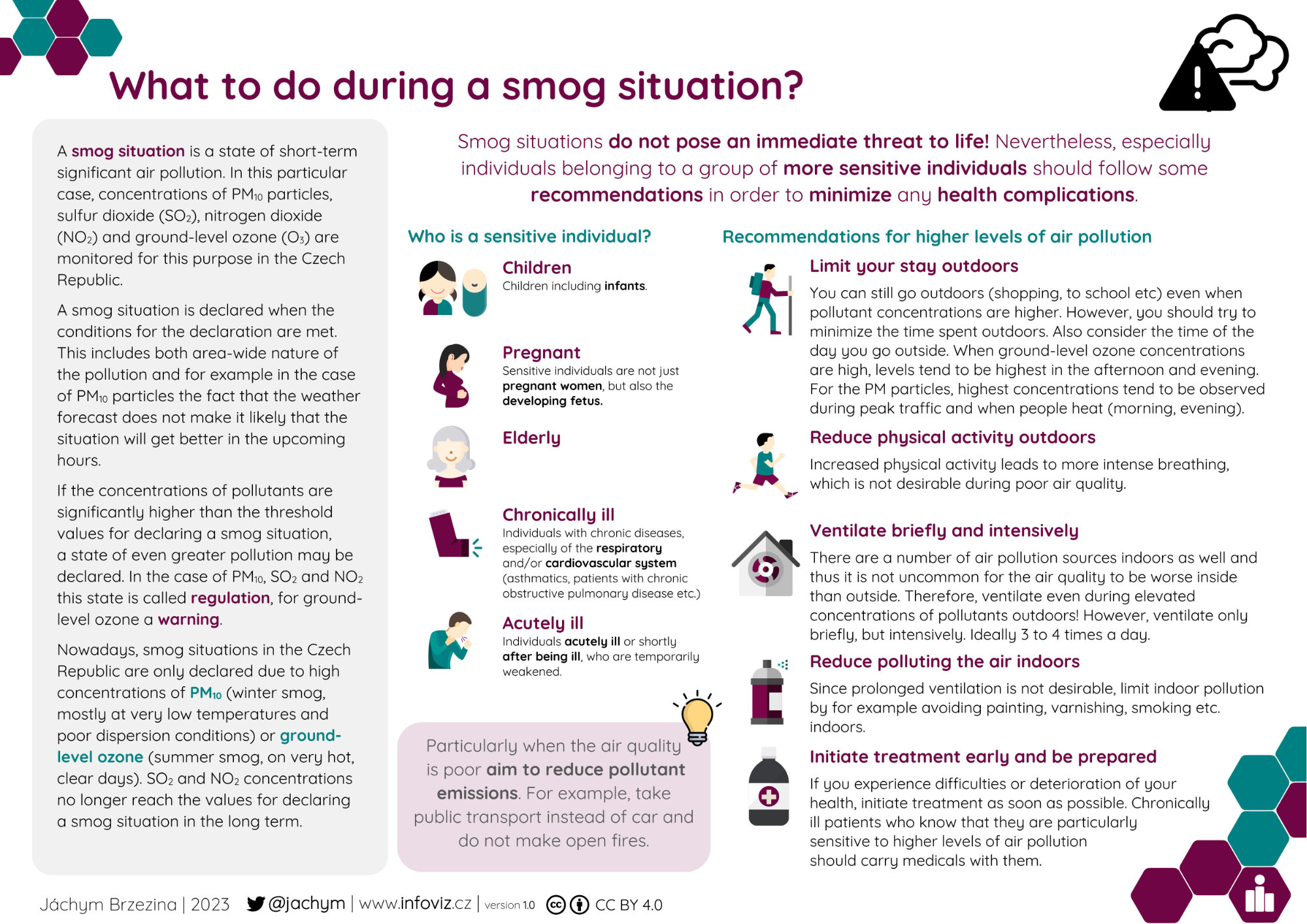Infographic transcript
A smog situation is a state of short-term significant air pollution. In this particular case, concentrations of PM10 particles, sulfur dioxide (SO2), nitrogen dioxide (NO2) and ground-level ozone (O3) are monitored for this purpose in the Czech Republic.
A smog situation is declared when the conditions for the declaration are met. This includes both area-wide nature of the pollution and for example in the case of PM10 particles the fact that the weather forecast does not make it likely that the situation will get better in the upcoming hours.
If the concentrations of pollutants are significantly higher than the threshold values for declaring a smog situation, a state of even greater pollution may be declared. In the case of PM10, SO2 and NO2 this state is called regulation, for ground-level ozone a warning.
Nowadays, smog situations in the Czech Republic are only declared due to high concentrations of PM10 (winter smog, mostly at very low temperatures and poor dispersion conditions) or ground-level ozone (summer smog, on very hot, clear days). SO2 and NO2 concentrations no longer reach the values for declaring a smog situation in the long term.
Smog situations do not pose an immediate threat to life! Nevertheless, especially individuals belonging to a group of more sensitive individuals should follow some recommendations in order to minimize any health complications.
Particularly when the air quality is poor aim to reduce pollutant emissions. For example, take public transport instead of car and do not make open fires.
Who is a sensitive individual?
- Children - Children including infants.
- Pregnant - Sensitive individuals are not just pregnant women, but also the developing fetus.
- Elderly
- Chronically ill - Individuals with chronic diseases, especially of the respiratory and/or cardiovascular system (asthmatics, patients with chronic obstructive pulmonary disease etc.)
- Acutely ill - Individuals acutely ill or shortly after being ill, who are temporarily weakened.
Recommendations for higher levels of air pollution
- Limit your stay outdoors
You can still go outdoors (shopping, to school etc) even when pollutant concentrations are higher. However, you should try to minimize the time spent outdoors. Also consider the time of the day you go outside. When ground-level ozone concentrations are high, levels tend to be highest in the afternoon and evening. For the PM particles, highest concentrations tend to be observed during peak traffic and when people heat (morning, evening). - Reduce physical activity outdoors
Increased physical activity leads to more intense breathing, which is not desirable during poor air quality. - Ventilate briefly and intensively
There are a number of air pollution sources indoors as well and thus it is not uncommon for the air quality to be worse inside than outside. Therefore, ventilate even during elevated concentrations of pollutants outdoors! However, ventilate only briefly, but intensively. Ideally 3 to 4 times a day. - Reduce polluting the air indoors
Since prolonged ventilation is not desirable, limit indoor pollution by for example avoiding painting, varnishing, smoking etc. indoors. - Initiate treatment early and be prepared
If you experience difficulties or deterioration of your health, initiate treatment as soon as possible. Chronically ill patients who know that they are particularly sensitive to higher levels of air pollution should carry medicals with them.
